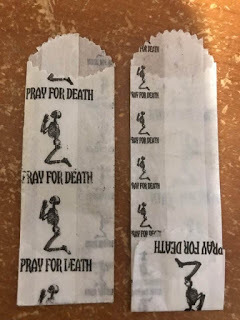Abstinence,Death, and How to Change the Opioid EpidemicBy...
Abstinence,Death, and How to Change the Opioid Epidemic ByCharlesAtkins, MD
(First published in the CT Mirror October 25, 2019)

I chair death reviews. It’s part of my job as a medicaldirector for a mental health and substance abuse agency. In recent years thebulk of deaths have been from opioid overdoses, now mostly fentanyl. The most-commonthemes are people who just left rehab, a detox program, or were released fromprison. What has become clear is that abstinence-only approaches and programsfor opioids don’t work, yet we continue to promote, practice, and pay for modelsthat are ineffective and deadly. While some opioid data is open to interpretation, certainfigures hold up. Over the course of a year, about 80 percent of people who wantto be substance free will have at least one slip, closer to 90 percent forpeople with more severe problems with drugs and alcohol and for those who alsohave mental health issues or have been incarcerated. These lapse rates hold true regardless of the drug, fromtobacco to heroin. But a lapse doesn’t equate to failure. It could be a one- ortwo-time thing and then they’ll return to their earlier goal to be substancefree. Here’sthe disconnect. A lapse with alcohol, tobacco, or cocaine might be unwanted, butit probably won’t kill you today. Yes, cigarettes will eventually give you cancer, heart disease, and a stroke, and afterforty years of hard drinking, your liver dies… and so do you. But not today. Thisis where opioids differ and why abstinence approaches in the age of Oxycontin,black tar heroin, and now fentanyl are dangerous and, in the face of hard data,possibly immoral. Studies that have looked at 30-day abstinence programsfor opioids show that over half their graduates relapse within a week ofdischarge, often on the ride home. Forty years ago, when the heroin on thestreet was less than 10 percent pure, that might not have killed you. But inour current epidemic, which involves high-octane fentanyls that start at 50 to100times more potent than morphine and carfentanil that can be over 10,000 timesstronger, all it takes is two bags that cost six bucks on the streets of NewBritain, Hartford, or New Haven and we have another death. Daily opioid users become dependent on the drugs anddevelop tolerance. They need to take more drug to achieve the same effect, andshould they go even a few hours without, they experience withdrawal symptoms thatleave them sick, incapacitated, miserable, and craving. With traditional detoxprograms, people are weaned off the opioids, kept in a sheltered environment,and then discharged, often back to the same environment, stresses, and peoplewith whom they used. Their tolerance to the drugs is gone, and a dose they oncefound safe is now fatal. Many parents who’ve lost children echo stories of howtheir child used a bag of fentanyl-adulterated heroin on the way home fromtreatment and it killed them. But people like abstinence. I do too. How lovely ifsomeone could take a problem behavior and just stop. And in those 80 and 90 percentrelapse rates are 10 and 20 percent minorities who manage to quit and stay quit—someon the first try, some on the fiftieth. But preferences and likes that are notsupported by data have no place in medicine and public health policy. Yet wecontinue to promote models of care that kill people with opioid use disorders. Eventhough we know these are chronic conditions that will have lapses, we deny andrestrict treatment based on positive drugs screens and the very behavior (druguse) that brings the person in for help. Nowhere else in medicine do we takesuch a punitive stance. I can’t imagine telling a person with insulin-dependentdiabetes that if they continue to binge on Ben and Jerry’s, we’ll withholdtheir medication because by giving it to them we’re “enabling” theirdestructive behavior. We don’t do that. We work with that person—provideeducation, help them establish workable treatment goals, and nudge them along.It’s a harm reduction, risk-lowering strategy. For those unfamiliar with harm reduction, it describespublic health approaches to risky behaviors. Every time you put a seatbelt on,you’ve performed an act of harm reduction. Yes, there’s still the chance thatyou’ll get hit on the highway, but you’ve improved your odds of survival. Harmreduction strategies for people who use drugs—including opioids—have beenaround for decades and include sterile needle exchange, rapid access toeffective medications for opioid use disorders (methadone, buprenorphine,naloxone), overdose kits (naltrexone/Narcan), decriminalization of low-leveldrug-related behaviors, education, free condoms, and safe and supervised placesfor people to use their drugs so they don’t die if they get in trouble. Outcomesfrom many studies are overwhelmingly positive, especially in countries who’veused these approaches for decades. Results include greatly decreased rates ofdisease transmission (HIV/AIDs, Hepatitis), lower medical problems related toinjection drug use, fewer deaths, fewer incarcerations, higher quality of life,and lower overall cost to the taxpayer. Inour current avalanche of overdose deaths treatment algorithms must consider thereality that most people will relapse. But they need not die because of it. So,as we face a central question of our opioid epidemic, how do we turn back thistide of death? Answers stare back at us. We have to step away from abstinence-onlyapproaches, such as arbitrary “three-strikes and you’re out” policies and detoxprotocols that don’t include the use of proven medications. And for those whocontinue to use street drugs and are not at the point of entering treatment,community outreach is key, and it needs to include access to sterile needleexchange, overdose kits (naloxone/Narcan), education about safer drug use, anopen invitation to treatment that is readily available, and safe places forpeople to use their drugs.
Bio—Bio: Charles Atkins, M.D. is apsychiatrist, author, clinical trainer, and member of the Yale volunteerfaculty. His most recent book on thistopic is Opioid Use Disorders: A HolisticGuide to Assessment, Treatment and Recovery. His web site is www.charlesatkins.com
Published on December 18, 2019 10:00
No comments have been added yet.



